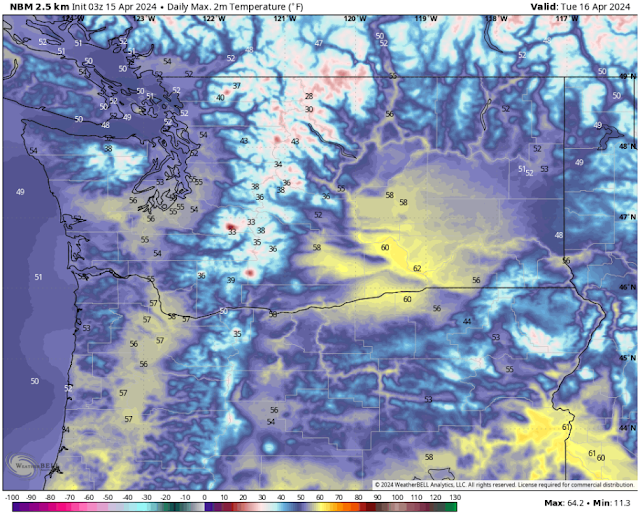FastCast--Thursday, May 9 to Tuesday, May 14:
A spring "heat wave" is ahead for the Northwest, with the warmest temperatures seen in months likely from Friday to Sunday. In the lowlands, expect sunny conditions through midday Sunday, before partly to mostly cloudy conditions take over from midday Sunday through Tuesday. Lowland highs will reach the low to mid 70s on Thursday. Friday and Saturday will be the hottest days since late last summer, with lowland highs reaching the low to mid 80s, hottest from Seattle southward. Cooler marine air will return on Sunday, with highs dropping to the mid 70s. Continued marine air will bring temperatures down to the mid to upper 60s on Monday and Tuesday. Remember, although temperatures will be warm, the water is NOT! Water temperatures across the region are in the 40s to low 50s, with some mountain-fed rivers in the 30s! These water conditions can cause severe health emergencies or even death. Be extremely careful around water during this warm spell.
----------------------------------------------------------------------------
Continue reading the full blog below!
Warm weather is here! The warmest temperatures of 2024 (so far) are expected over the next few days, from Friday to Sunday, depending on what part of the state you're in. Let's take a look at the forecast!
First, the NWS NBM model high-resolution forecast for highs on Thursday, seen below.
Expect lowland highs to reach the low to mid 70s, with areas east of I-5 and south of Olympia reaching the upper 70s. The coast will reach the mid 60s on the beaches to mid 70s just inland, and the Willamette Valley will reach the upper 70s to low 80s. Eastern Washington will reach the mid 70s to low 80s, warmest in valleys and around the Tri-Cities.
Next, let's take a look at Friday's forecast, also from the NWS NBM model.
Friday will likely be the first 80°+ day of 2024 for most areas from Everett southward. Expect highs in the low to mid 80s from Seattle southward, and in the mid 70s to low 80s from Everett northward. The hottest temperatures will be in the mid 80s, mainly in mountain valleys. The coast will reach the low 70s (hottest day in this stretch along the coast), while the Willamette Valley will reach the upper 80s, with an outside chance at the Portland area reaching the low 90s. Eastern Washington will also be quite warm, with highs across the region in the upper 70s to mid 80s, hottest in the lower Columbia Basin.
We'll continue into the weekend, taking a look at Saturday's highs below, from the NWS NBM model.
On Saturday, the lowlands will reach the mid to upper 70s north of Everett, and the low to mid 80s south of Everett. There is potential for low 80s to be more widespread across the North Sound. The Willamette Valley will reach the mid to upper 80s, while Eastern Washington will reach the low 80s near Spokane to the low 90s in the Columbia Basin. Cities like Yakima and the Tri-Cities will likely reach the low 90s. Notice that on the coast, temperatures will drop to the low 60s on the beaches and mid to upper 60s inland. That's the "natural air conditioning" of the Pacific Northwest moving in.
The effect of that "natural A/C" (and incoming clouds) will be seen west of the Cascades on Sunday, as the NWS NBM model forecast shows.
On Sunday, temperatures west of the Cascades will decrease noticeably. Expect the lowlands to drop to the low to mid 70s, while the Willamette Valley will drop to the upper 70s. The coast will be much cooler, with highs in the upper 50s to low 60s. However, notice that the cooler marine air hasn't reached Eastern Washington, where highs will remain in the low 80s near Spokane to upper 80s/low 90s for the Columbia Basin.
Temperatures statewide will decrease on Monday and Tuesday as cooler marine air moves through. However, rain remains unlikely for at least the next 7 days, possibly longer.
What is causing such a nice stretch in mid-May? That question is easily answered by looking at the European model forecast for Friday morning, showing atmospheric pressure at 18,000 feet (called 500 millibars in the weather world).
Notice the large high pressure ridge centered just offshore of the Pacific Northwest and over Southern BC. This ridge has the proper placement and strength to bring a short-lived heat wave to the region. In summer, the overall pattern favors ridges like this being larger, stronger, and lasting longer, contributing to more intense heat waves.
However, regardless of the strength of this heat wave, adverse impacts are still possible, especially if you are recreating in the water. Take a look at the very informative graphic below from NWS Seattle, showing the dangers of the region's very cold water.
Consider these reminders if you're around the water while it's hot outside. Remember how cold and dangerous our waters can be!
Stay tuned for more information about the hot weather and extended forecast!





















































